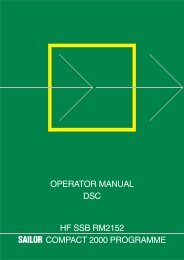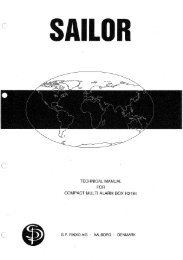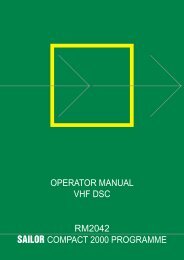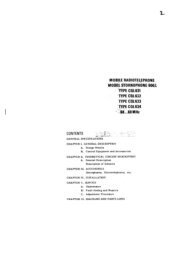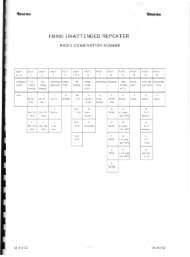TECHNICAL MANUAL FOR COMPACT VHF DSC RM2042
TECHNICAL MANUAL FOR COMPACT VHF DSC RM2042
TECHNICAL MANUAL FOR COMPACT VHF DSC RM2042
You also want an ePaper? Increase the reach of your titles
YUMPU automatically turns print PDFs into web optimized ePapers that Google loves.
5 CIRCUIT DESCRIPTION AND SCHEMATIC DIAGRAMS <strong>RM2042</strong>5.4 DISPLAY UNIT (MODULE 4) PART NO. 626944An LCD display of 2 times 24 characters with LED backlight is used to read out information to the operator.DISPLAY MODULEThe display module is mounted on top of the display unit by means of two connectors and four screws.The display module has a dot matrix LCD display with 2 times 24 characters and a build-in LCD drivercontroller. This controller has a built-in character generator and a display data RAM. All the displayfunctions are controlled by instructions from the microprocessor.DISPLAY INTERFACEThe display is interfaced with the microprocessor (module 2) through the ribbon cable connector P4.The display enable pulse (E signal) is led directly to the LCD display by means of the strap field P5.The delay circuit consisting of four NAND gates (U4) and three buffers (U5) is not used in this product,but nevertheless it is mounted, because the display unit also is used in other of our products.BRIGHTNESS CONTROLBrightness or viewing angle control is performed by a four bit digital to analog converter, which gives 16steps for regulation.The D/A converter is build-up around four D-type flip-flops integreted in U1 and the operational amplifierU2.1. The four D-type flip-flops is used as parallel input/output latches and each of the output pins Q1,Q2, Q3 and Q4 are connected through one of the resistors R6, R8, R9 and R10 to the inverting input ofU2.1.The output voltage from the D/A converter (i.e. output at U2.1) is divided by 2 by means of two resistors(R16 and R18) and is then led to the non-inverting input at the amplifier U2.4. The inverting input at thisamplifier is connected to a resistor network, which include the NTC resistor R12. This circuit compensatesfor the temperature change of the brightness controle voltage.The output from the amplifier U2.4 is connected to the display brightness controle at pin 6 in the connectorJ1.BACKLIGHT CONTROLThe current through the backlight LED’s is controlled by the transistor Q1, which again is controlled bythe amplifier circuit build-up around U2.2.The current running in the backlight LED’s is also running through the emitter resistors and the voltageacross R25 and R28 is therefore a function of the backlight current.This voltage will almost be equal to the voltage at the non-inverting terminale, because of the relative largevoltage gain given by the ratio of R20 to R22.The voltage at the non-inverting input is only determined by the two flip-flops Q5 and Q6 integreted in U1and the voltage divider given by the resistors R21, R23 and R24. The current running in the emitter of Q1can therefore be controlled by combinating the digital outputs from U1. This means, that the currentrunning through the backlight LED’s can be controlled by U1 in four steps, with step 1 as 0 mA and step 4as 180 mA.9716PAGE 5-23





